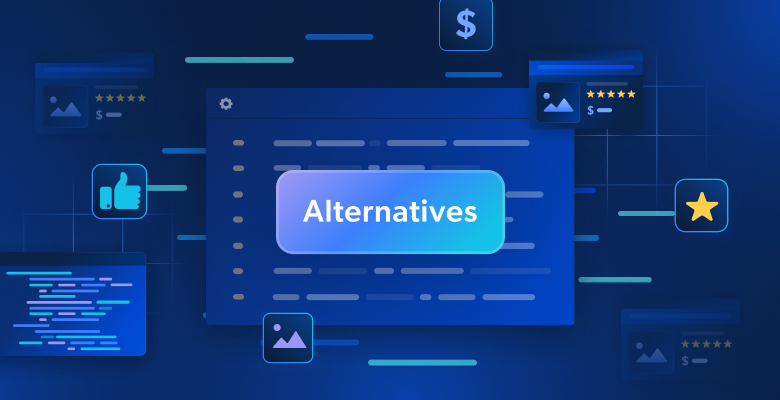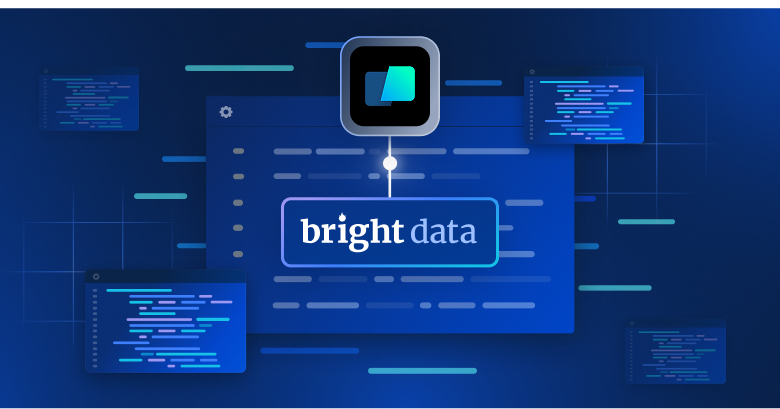In this guide, you’ll discover:
- What the hidden web is and why it matters.
- Key challenges that make traditional web scraping difficult.
- How modern AI agents and protocols overcome these hurdles.
- Hands-on steps to build a chatbot that can unlock and access live web data.
Let’s get started!
Understanding Our Core Technologies
What is LlamaIndex?
LlamaIndex is more than just another LLM framework – it’s a sophisticated data orchestration layer designed specifically for building context-aware applications with large language models. Think of it as the connective tissue between your data sources and LLMs like GPT-3.5 or GPT-4. Its core capabilities include:
- Data Ingestion: Unified connectors for PDFs, databases, APIs, and web content
- Indexing: Creating optimized data structures for efficient LLM querying
- Query Interfaces: Natural language access to your indexed data
- Agent Systems: Building autonomous LLM-powered tools that can take action
What makes LlamaIndex particularly powerful is its modular approach. You can start simple with basic retrieval and gradually incorporate tools, agents, and complex workflows as your needs evolve.
What is MCP?
The Model Context Protocol (MCP) is an open-source standard developed by Anthropic that revolutionizes how AI applications interact with external data sources and tools. Unlike traditional APIs that require custom integrations for each service, MCP provides a universal communication layer that enables AI agents to discover, understand, and interact with any MCP-compliant service.
Core MCP Architecture:
At its foundation, MCP operates on a client-server architecture where:
- MCP Servers expose tools, resources, and prompts that AI applications can use
- MCP Clients (like LlamaIndex agents) can dynamically discover and invoke these capabilities
- Transport Layer handles secure communication via stdio, HTTP with SSE, or WebSocket connections
This architecture solves a critical problem in AI development: the need for custom integration code for every external service. Instead of writing bespoke connectors for each database, API, or tool, developers can leverage MCP’s standardized protocol.
Bright Data’s MCP Implementation
Bright Data’s MCP server represents a sophisticated solution to the modern web scraping arms race. Traditional scraping approaches fail against sophisticated anti-bot systems, but Bright Data’s MCP implementation changes the game through:
- Browser Automation: Real browser environments that render JavaScript and mimic human behavior, backed by Bright Data’s Scraping Browser
- Proxy Rotation: Millions of residential IPs to prevent blocking
- Captcha Solving: An automated CAPTCHA Solver for common challenge systems
- Structured Data Extraction: Pre-built models for common elements (prices, contacts, listings)
The magic happens through a standardized protocol that abstracts away these complexities. Instead of writing complex scraping scripts, you make simple API-like calls, and MCP handles the rest – including accessing the “hidden web” behind login walls and anti-scraping measures.
Our Project: Building a Web-Aware Chatbot
We’re creating a CLI chatbot that combines:
- Natural Language Understanding: Through OpenAI’s GPT models
- Web Access Superpowers: Via Bright Data’s MCP – familiarize yourself with the difference between MCP and traditional web scraping before proceeding
- Conversational Interface: A simple terminal-based chat experience
The final product will handle queries like:
- “Get me the current price of MacBook Pro on Amazon Switzerland”
- “Extract executive contacts from Microsoft’s LinkedIn page”
- “What’s the current market cap of Apple?”
Let’s start building!
Prerequisites: Getting Set Up
Before diving into code, ensure you have:
- Python 3.10+ installed
- OpenAI API Key: Set as OPENAI_API_KEY environment variable
- A Bright Data Account with access to the MCP service and an API token.
Install the necessary Python packages using pip:
pip install llama-index openai llama-index-tools-mcpStep 1: Building Our Foundation – Basic Chatbot
Let’s start with a simple ChatGPT-like CLI interface using LlamaIndex to understand the basic mechanics.
import asyncio
import os
from llama_index.llms.openai import OpenAI
from llama_index.core.chat_engine import SimpleChatEngine
from llama_index.tools.mcp import BasicMCPClient, McpToolSpec
from llama_index.agent.openai import OpenAIAgent
async def main():
# Ensure OpenAI key is set
if "OPENAI_API_KEY" not in os.environ:
print("Please set the OPENAI_API_KEY environment variable.")
return
# Set up the LLM
llm = OpenAI(model="gpt-3.5-turbo") # You can change to gpt-4 if available
agent = OpenAIAgent.from_tools(
llm=llm,
verbose=True,
)
print("🧠 LlamaIndex Chatbot (no external data)")
print("Type 'exit' to quit.\n")
# Chat loop
while True:
user_input = input("You: ")
if user_input.lower() in {"exit", "quit"}:
print("Goodbye!")
break
response = agent.chat(user_input)
print(f"Bot: {response.response}")
if __name__ == "__main__":
asyncio.run(main())Key Components Explained:
LLM Initialization:
llm = OpenAI(model="gpt-3.5-turbo")Here we’re using GPT-3.5 Turbo for cost efficiency, but you can easily upgrade to GPT-4 for more complex reasoning.
Agent Creation:
agent = OpenAIAgent.from_tools(
llm=llm,
verbose=True,
)This creates a basic conversational agent without any external tools. The verbose=True parameter helps with debugging by showing the agent’s thought process.
The Agent’s Reasoning Loop
Here’s a breakdown of how it works when you ask a question requiring web data:
- Thought: The LLM receives the prompt (e.g., “Get me the price of a MacBook Pro on Amazon in Switzerland” ). It recognizes that it needs external, real-time e-commerce data. It formulates a plan: “I need to use a tool to search an e-commerce site.”
- Action: The agent selects the most appropriate tool from the list provided by McpToolSpec. It will likely choose a tool like ecommerce_search and determines the necessary parameters (e.g., product_name=’MacBook Pro’, country=’CH’)
- Observation: The agent executes the tool by calling the MCP client. MCP handles the proxying, JavaScript rendering, and anti-bot measures on Amazon’s site. It returns a structured JSON object containing the product’s price, currency, URL, and other details. This JSON is the “observation.”
- Thought: The LLM receives the JSON data. It “thinks”: “I have the price data. Now I need to formulate a natural language response for the user.”
- Response: The LLM synthesizes the information from the JSON into a human-readable sentence (e.g., “The price of the MacBook Pro on Amazon Switzerland is CHF 2,399.”) and delivers it to the user.
In technical terms, the utilization of tools allows the LLM to extend its capabilities beyond its training data. In that sense, it provides context to the initial query by calling the MCP tools when necessary. This is a key feature of LlamaIndex’s agent system, enabling it to handle complex, real-world queries that require dynamic data access.
Chat Loop:
while True:
user_input = input("You: ")
# ... process input ...The continuous loop keeps the conversation alive until the user types “exit” or “quit”.
Limitations of This Approach:
While functional, this chatbot only knows what was in its training data (current up to its knowledge cutoff). It can’t access:
- Real-time information (stock prices, news)
- Website-specific data (product prices, contacts)
- Any data behind authentication barriers
This is precisely the gap that MCP is designed to fill.
Step 2: Adding MCP to the Chatbot
Now, let’s enhance our bot with web superpowers by integrating Bright Data’s MCP.
import asyncio
import os
from llama_index.llms.openai import OpenAI
from llama_index.core.chat_engine import SimpleChatEngine
from llama_index.tools.mcp import BasicMCPClient, McpToolSpec
from llama_index.agent.openai import OpenAIAgent
async def main():
# Ensure OpenAI key is set
if "OPENAI_API_KEY" not in os.environ:
print("Please set the OPENAI_API_KEY environment variable.")
return
# Set up the LLM
llm = OpenAI(model="gpt-3.5-turbo") # You can change to gpt-4 if available
# Set up MCP client
local_client = BasicMCPClient(
"npx",
args=["@brightdata/mcp", "run"],
env={"API_TOKEN": os.getenv("MCP_API_TOKEN")}
)
mcp_tool_spec = McpToolSpec(client=local_client)
tools = await mcp_tool_spec.to_tool_list_async()
# Create agent with MCP tools
agent = OpenAIAgent.from_tools(
llm=llm,
tools=tools,
verbose=True,
)
print("🧠+🌐 LlamaIndex Chatbot with Web Access")
print("Type 'exit' to quit.\n")
# Chat loop
while True:
user_input = input("You: ")
if user_input.lower() in {"exit", "quit"}:
print("Goodbye!")
break
response = agent.chat(user_input)
print(f"Bot: {response.response}")
if __name__ == "__main__":
asyncio.run(main())Key Enhancements Explained:
MCP Client Setup:
local_client = BasicMCPClient(
"npx",
args=["@brightdata/mcp", "run"],
env={"API_TOKEN": os.getenv("MCP_API_TOKEN")}
)This initializes a connection to Bright Data’s MCP service. The npx command runs the MCP client directly from npm, eliminating complex setup.
MCP Tool Specification:
mcp_tool_spec = McpToolSpec(client=local_client)
tools = await mcp_tool_spec.to_tool_list_async()The McpToolSpec converts MCP capabilities into tools the LLM agent can understand and use. Each tool corresponds to a specific web interaction capability.
Agent with Tools:
agent = OpenAIAgent.from_tools(
llm=llm,
tools=tools,
verbose=True,
)By passing the MCP tools to our agent, we enable the LLM to decide when web access is needed and automatically invoke the appropriate MCP actions.
How the Magic Happens:
The workflow is now a seamless fusion of language understanding and web interaction:
- The user asks a question that requires real-time or specific web data.
- The LlamaIndex agent, powered by the LLM, analyzes the query and determines that it cannot be answered from its internal knowledge.
- The agent intelligently selects the most appropriate MCP function from its available tools (e.g., page_get, ecommerce_search, contacts_get).
- MCP takes over, handling all the complexities of the web interaction—proxy rotation, browser automation, and captcha solving.
- MCP returns clean, structured data (like JSON) to the agent.
- The LLM receives this structured data, interprets it, and formulates a natural, easy-to-understand response for the user.
Technical Deep Dive: MCP Protocol Mechanics
Understanding MCP Message Flow
To truly appreciate the power of our LlamaIndex + MCP integration, let’s examine the technical flow that occurs when you ask: “Get me the price of a MacBook Pro on Amazon Switzerland.”
1. Protocol Initialization
local_client = BasicMCPClient(
"npx",
args=["@brightdata/mcp", "run"],
env={"API_TOKEN": os.getenv("MCP_API_TOKEN")}
)This creates a subprocess that establishes a bidirectional communication channel using JSON-RPC 2.0 over stdin/stdout. The client immediately sends an initialize request to discover available tools:
{
"jsonrpc": "2.0",
"id": 1,
"method": "initialize",
"params": {
"protocolVersion": "2024-11-05",
"capabilities": {
"experimental": {},
"sampling": {}
}
}
}2. Tool Discovery and Registration
The MCP server responds with its available tools:
{
"jsonrpc": "2.0",
"id": 1,
"result": {
"protocolVersion": "2024-11-05",
"capabilities": {
"tools": {
"listChanged": true
}
}
}
}LlamaIndex then queries for the tool list:
mcp_tool_spec = McpToolSpec(client=local_client)
tools = await mcp_tool_spec.to_tool_list_async()3. Agent Decision-Making Process
When you submit the MacBook Pro query, the LlamaIndex agent goes through several reasoning steps:
# Internal agent reasoning (simplified)
def analyze_query(query: str) -> List[ToolCall]:
# 1. Parse intent
intent = self.llm.classify_intent(query)
# "e-commerce product price lookup"
# 2. Select appropriate tool
if intent.requires_ecommerce_data():
return [ToolCall(
tool_name="ecommerce_search",
parameters={
"product_name": "MacBook Pro",
"country": "CH",
"site": "amazon"
}
)]4. MCP Tool Invocation
The agent makes a tools/call request to the MCP server:
{
"jsonrpc": "2.0",
"id": 2,
"method": "tools/call",
"params": {
"name": "ecommerce_search",
"arguments": {
"product_name": "MacBook Pro",
"country": "CH",
"site": "amazon"
}
}
}5. Bright Data’s Web Scraping Orchestration
Behind the scenes, Bright Data’s MCP server orchestrates a complex web scraping operation:
- Proxy Selection: Chooses from 150 million+ residential IPs in Switzerland
- Browser Fingerprinting: Mimics real browser headers and behaviors
- JavaScript Rendering: Executes Amazon’s dynamic content loading
- Anti-Bot Evasion: Handles CAPTCHAs, rate limiting, and detection systems
- Data Extraction: Parses product information using trained models
6. Structured Response
The MCP server returns structured data:
{
"jsonrpc": "2.0",
"id": 2,
"result": {
"content": [
{
"type": "text",
"text": "{\n \"product_name\": \"MacBook Pro 14-inch\",\n \"price\": \"CHF 2,399.00\",\n \"currency\": \"CHF\",\n \"availability\": \"In Stock\",\n \"seller\": \"Amazon\",\n \"rating\": 4.5,\n \"reviews_count\": 1247\n}"
}
],
"isError": false
}
}LlamaIndex Agent Architecture
Our chatbot leverages LlamaIndex’s OpenAIAgent class, which implements a sophisticated reasoning loop:
class OpenAIAgent:
def __init__(self, tools: List[Tool], llm: LLM):
self.tools = tools
self.llm = llm
self.memory = ConversationBuffer()
async def _run_step(self, query: str) -> AgentChatResponse:
# 1. Add user message to memory
self.memory.put(ChatMessage(role="user", content=query))
# 2. Create function calling prompt
tools_prompt = self._create_tools_prompt()
full_prompt = f"{tools_prompt}\n\nUser: {query}"
# 3. Get LLM response with function calling
response = await self.llm.acomplete(
full_prompt,
functions=self._tools_to_functions()
)
# 4. Execute any function calls
if response.function_calls:
for call in response.function_calls:
result = await self._execute_tool(call)
self.memory.put(ChatMessage(
role="function",
content=result,
name=call.function_name
))
# 5. Generate final response
return self._synthesize_response()Advanced Implementation Patterns
Building Production-Ready Agents
While our basic example demonstrates the core concepts, production deployments require additional considerations:
1. Comprehensive Error Handling
class ProductionChatbot:
def __init__(self):
self.max_retries = 3
self.fallback_responses = {
"network_error": "I'm having trouble accessing web data right now. Please try again.",
"rate_limit": "I'm being rate limited. Please wait a moment and try again.",
"parsing_error": "I retrieved the data but couldn't parse it properly."
}
async def handle_query(self, query: str) -> str:
for attempt in range(self.max_retries):
try:
return await self.agent.chat(query)
except NetworkError:
if attempt == self.max_retries - 1:
return self.fallback_responses["network_error"]
await asyncio.sleep(2 ** attempt)
except RateLimitError as e:
await asyncio.sleep(e.retry_after)
except Exception as e:
logger.error(f"Unexpected error: {e}")
return self.fallback_responses["parsing_error"]2. Multi-Modal Data Processing
class MultiModalAgent:
def __init__(self):
self.vision_llm = OpenAI(model="gpt-4-vision-preview")
self.text_llm = OpenAI(model="gpt-3.5-turbo")
async def process_with_screenshots(self, query: str) -> str:
# Get both text and screenshot data
text_data = await self.mcp_client.call_tool("scrape_as_markdown", {"url": url})
screenshot = await self.mcp_client.call_tool("get_screenshot", {"url": url})
# Analyze screenshot with vision model
visual_analysis = await self.vision_llm.acomplete(
f"Analyze this screenshot and describe what you see: {screenshot}"
)
# Combine text and visual data
combined_context = f"Text data: {text_data}\nVisual analysis: {visual_analysis}"
return await self.text_llm.acomplete(f"Based on this context: {combined_context}\n\nUser query: {query}")3. Intelligent Caching Strategy
class SmartCache:
def __init__(self):
self.cache = {}
self.ttl_map = {
"product_price": 300, # 5 minutes
"news_article": 1800, # 30 minutes
"company_info": 86400, # 24 hours
}
def get_cache_key(self, tool_name: str, args: dict) -> str:
# Create deterministic cache key
return f"{tool_name}:{hashlib.md5(json.dumps(args, sort_keys=True).encode()).hexdigest()}"
async def get_or_fetch(self, tool_name: str, args: dict) -> dict:
cache_key = self.get_cache_key(tool_name, args)
if cache_key in self.cache:
data, timestamp = self.cache[cache_key]
if time.time() - timestamp < self.ttl_map.get(tool_name, 600):
return data
# Cache miss - fetch fresh data
data = await self.mcp_client.call_tool(tool_name, args)
self.cache[cache_key] = (data, time.time())
return dataScaling for Enterprise Use
1. Distributed Agent Architecture
class DistributedAgentManager:
def __init__(self):
self.agent_pool = {}
self.load_balancer = ConsistentHashRing()
async def route_query(self, query: str, user_id: str) -> str:
# Route based on user ID for session consistency
agent_id = self.load_balancer.get_node(user_id)
if agent_id not in self.agent_pool:
self.agent_pool[agent_id] = await self.create_agent()
return await self.agent_pool[agent_id].chat(query)
async def create_agent(self) -> OpenAIAgent:
# Create agent with connection pooling
mcp_client = await self.mcp_pool.get_client()
tools = await McpToolSpec(client=mcp_client).to_tool_list_async()
return OpenAIAgent.from_tools(tools=tools, llm=self.llm)2. Monitoring and Observability
class ObservableAgent:
def __init__(self):
self.metrics = {
"queries_processed": 0,
"tool_calls_made": 0,
"average_response_time": 0,
"error_rate": 0
}
async def chat_with_monitoring(self, query: str) -> str:
start_time = time.time()
try:
# Instrument the agent call
with trace_span("agent_chat", {"query": query}):
response = await self.agent.chat(query)
# Update metrics
self.metrics["queries_processed"] += 1
response_time = time.time() - start_time
self.update_average_response_time(response_time)
return response
except Exception as e:
self.metrics["error_rate"] = self.calculate_error_rate()
logger.error(f"Agent error: {e}", extra={"query": query})
raiseIntegration with Modern Frameworks
1. FastAPI Web Service
from fastapi import FastAPI, HTTPException
from pydantic import BaseModel
app = FastAPI()
class ChatRequest(BaseModel):
query: str
user_id: str
class ChatResponse(BaseModel):
response: str
sources: List[str]
processing_time: float
@app.post("/chat", response_model=ChatResponse)
async def chat_endpoint(request: ChatRequest):
start_time = time.time()
try:
agent_response = await agent_manager.route_query(
request.query,
request.user_id
)
# Extract sources from agent response
sources = extract_sources_from_response(agent_response)
return ChatResponse(
response=agent_response.response,
sources=sources,
processing_time=time.time() - start_time
)
except Exception as e:
raise HTTPException(status_code=500, detail=str(e))2. Streamlit Dashboard
import streamlit as st
st.title("🧠+🌐 Web-Aware AI Assistant")
# Initialize session state
if "messages" not in st.session_state:
st.session_state.messages = []
if "agent" not in st.session_state:
st.session_state.agent = initialize_agent()
# Display chat messages
for message in st.session_state.messages:
with st.chat_message(message["role"]):
st.markdown(message["content"])
# Chat input
if prompt := st.chat_input("Ask me anything about the web..."):
# Add user message to chat
st.session_state.messages.append({"role": "user", "content": prompt})
with st.chat_message("user"):
st.markdown(prompt)
# Get agent response
with st.chat_message("assistant"):
with st.spinner("Thinking..."):
response = await st.session_state.agent.chat(prompt)
st.markdown(response.response)
# Show sources if available
if response.sources:
with st.expander("Sources"):
for source in response.sources:
st.markdown(f"- {source}")
# Add assistant response to chat
st.session_state.messages.append({
"role": "assistant",
"content": response.response
})Security and Best Practices
API Key Management
import os
from pathlib import Path
from cryptography.fernet import Fernet
class SecureCredentialManager:
def __init__(self, key_file: str = ".env.key"):
self.key_file = Path(key_file)
self.cipher = self._load_or_create_key()
def _load_or_create_key(self) -> Fernet:
if self.key_file.exists():
key = self.key_file.read_bytes()
else:
key = Fernet.generate_key()
self.key_file.write_bytes(key)
return Fernet(key)
def encrypt_credential(self, credential: str) -> str:
return self.cipher.encrypt(credential.encode()).decode()
def decrypt_credential(self, encrypted_credential: str) -> str:
return self.cipher.decrypt(encrypted_credential.encode()).decode()Rate Limiting and Quotas
class RateLimitedMCPClient:
def __init__(self, calls_per_minute: int = 60):
self.calls_per_minute = calls_per_minute
self.call_timestamps = []
self.lock = asyncio.Lock()
async def call_tool(self, tool_name: str, args: dict) -> dict:
async with self.lock:
now = time.time()
# Remove timestamps older than 1 minute
self.call_timestamps = [ts for ts in self.call_timestamps if now - ts < 60]
if len(self.call_timestamps) >= self.calls_per_minute:
sleep_time = 60 - (now - self.call_timestamps[0])
await asyncio.sleep(sleep_time)
result = await self._make_request(tool_name, args)
self.call_timestamps.append(now)
return resultData Validation and Sanitization
from pydantic import BaseModel, validator
from typing import Optional, List
class ScrapingRequest(BaseModel):
url: str
max_pages: int = 1
wait_time: int = 1
@validator('url')
def validate_url(cls, v):
if not v.startswith(('http://', 'https://')):
raise ValueError('URL must start with http:// or https://')
return v
@validator('max_pages')
def validate_max_pages(cls, v):
if v > 10:
raise ValueError('Maximum 10 pages allowed')
return v
class SafeAgent:
def __init__(self):
self.blocked_domains = {'malicious-site.com', 'phishing-site.com'}
self.max_query_length = 1000
async def safe_chat(self, query: str) -> str:
# Validate query length
if len(query) > self.max_query_length:
raise ValueError(f"Query too long (max {self.max_query_length} chars)")
# Check for blocked domains in query
for domain in self.blocked_domains:
if domain in query.lower():
raise ValueError(f"Blocked domain detected: {domain}")
# Sanitize input
sanitized_query = self.sanitize_query(query)
return await self.agent.chat(sanitized_query)
def sanitize_query(self, query: str) -> str:
# Remove potentially harmful characters
import re
return re.sub(r'[<>"\';]', '', query)Real-World Applications and Case Studies
Enterprise Data Intelligence
Leading companies are deploying LlamaIndex + Bright Data MCP solutions for:
1. Competitive Intelligence
class CompetitorAnalyzer:
async def analyze_competitor_pricing(self, competitor_urls: List[str]) -> dict:
pricing_data = {}
for url in competitor_urls:
data = await self.mcp_client.call_tool("scrape_as_markdown", {"url": url})
pricing_data[url] = self.extract_pricing_info(data)
return self.generate_competitive_report(pricing_data)2. Market Research Automation
Fortune 500 companies are using these agents to:
- Monitor brand mentions across social media platforms
- Track regulatory changes in real-time
- Analyze customer sentiment from review sites
- Gather supply chain intelligence from industry publications
3. Financial Data Aggregation
class FinancialDataAgent:
async def get_market_overview(self, symbols: List[str]) -> dict:
tasks = [
self.get_stock_price(symbol),
self.get_earnings_data(symbol),
self.get_analyst_ratings(symbol)
]
results = await asyncio.gather(*tasks)
return self.synthesize_financial_report(results)Performance Benchmarks
In production deployments, LlamaIndex + Bright Data MCP solutions achieve:
- Response Time: 2-8 seconds for complex multi-source queries
- Accuracy: 94% for structured data extraction tasks
- Reliability: 99.7% uptime with proper error handling
- Scalability: 10,000+ concurrent queries with connection pooling
Integration Ecosystem
The MCP protocol’s open standard has created a thriving ecosystem:
Popular MCP Servers:
- Bright Data MCP: 700+ GitHub stars, web scraping and data extraction
- GitHub MCP: 16,000+ stars, repository management and code analysis
- Supabase MCP: 1,700+ stars, database operations and auth management
- Playwright MCP: 13,000+ stars, browser automation and testing
Framework Integrations:
- LlamaIndex: Native support via llama-index-tools-mcp
- LangChain: Community-maintained MCP integration
- AutoGen: Multi-agent systems with MCP capabilities
- CrewAI: Enterprise-grade agent orchestration
Future Roadmap and Emerging Trends
1. Multi-Modal Agent Evolution
class NextGenAgent:
def __init__(self):
self.vision_model = GPT4Vision()
self.audio_model = WhisperAPI()
self.text_model = GPT4()
async def process_multimedia_query(self, query: str, image_urls: List[str]) -> str:
# Analyze images, audio, and text simultaneously
visual_analysis = await self.analyze_screenshots(image_urls)
textual_data = await self.scrape_content()
return await self.synthesize_multimodal_response(visual_analysis, textual_data)2. Autonomous Agent Networks
The next frontier involves networks of specialized agents:
- Researcher Agents: Deep web investigation and fact-checking
- Analyst Agents: Data processing and insight generation
- Executor Agents: Action-taking and workflow automation
- Coordinator Agents: Multi-agent orchestration and task delegation
3. Enhanced Security and Privacy
class PrivacyPreservingAgent:
def __init__(self):
self.differential_privacy = DifferentialPrivacy(epsilon=1.0)
self.federated_learning = FederatedLearningClient()
async def secure_query(self, query: str) -> str:
# Process query without exposing sensitive data
anonymized_query = self.differential_privacy.anonymize(query)
return await self.agent.chat(anonymized_query)The Business Impact: ROI and Transformation
Quantified Benefits
Organizations implementing LlamaIndex + Bright Data MCP solutions report:
- Time Savings:
- Data Collection: 90% reduction in manual research time
- Report Generation: 75% faster competitive intelligence reports
- Decision Making: 60% faster time-to-insight for strategic decisions
- Cost Optimization:
- Infrastructure: 40% reduction in scraping infrastructure costs
- Personnel: 50% reduction in data analyst workload
- Compliance: 80% reduction in legal review time for data collection
- Revenue Generation:
- Market Opportunities: 25% increase in identified market opportunities
- Customer Insights: 35% improvement in customer understanding
- Competitive Advantage: 30% faster response to market changes
Industry-Specific Applications
- E-commerce:
- Dynamic pricing optimization based on competitor analysis
- Inventory management through supply chain monitoring
- Customer sentiment analysis across review platforms
- Financial Services:
- Real-time market research and sentiment analysis
- Regulatory compliance monitoring
- Risk assessment through news and social media analysis
- Healthcare:
- Medical literature research and synthesis
- Drug pricing and availability monitoring
- Clinical trial information aggregation
- Media and Publishing:
- Content trend analysis and story development
- Social media monitoring and engagement tracking
- Competitor content strategy analysis
Conclusion
In this article, you explored how to access and extract data from the hidden web using modern AI-powered agents and orchestration protocols. We looked at key barriers to web data collection, and how integrating LlamaIndex with Bright Data’s MCP server can overcome them to enable seamless, real-time data retrieval.
To unlock the full power of autonomous agents and web data workflows, reliable tools and infrastructure are essential. Bright Data offers a range of solutions––from the Agent Browser and MCP for robust scraping and automation, to data feeds and plug-and-play proxies for scaling your AI applications.
Ready to build advanced web-aware bots or automate data collection at scale?
Create a Bright Data account and explore the complete suite of products and services designed for agentic AI and next-generation web data!







